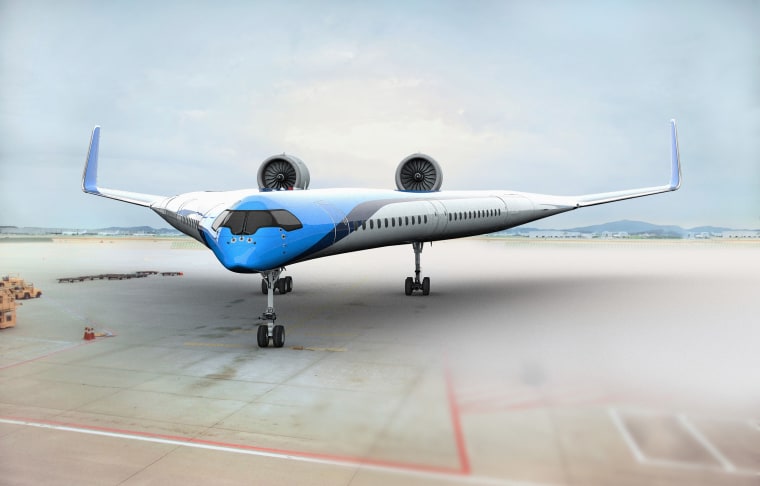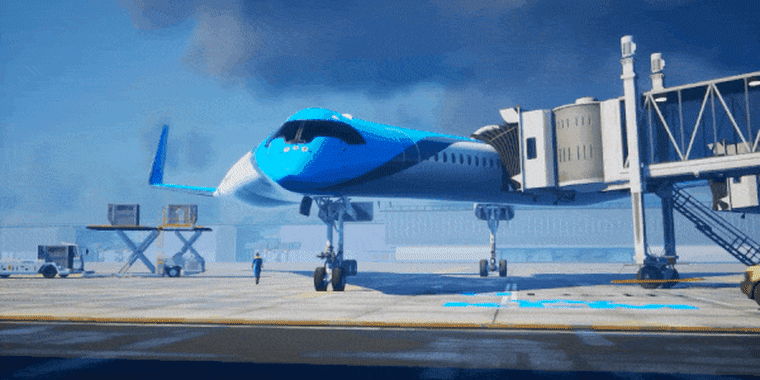A V-shaped airliner that seats passengers in the wings instead of a central fuselage could make long-distance air travel more sustainable — and it’s more than pie in the sky.
The Dutch airline KLM announced Monday that it would team up with Delft University of Technology to develop the lightweight, fuel-efficient “Flying-V” aircraft.
No plans for building the concept craft have yet been announced, but KLM said it would unveil a scale model and full-size section of the plane’s interior at Amsterdam’s Schiphol Airport in October.
Forgoing the fuselage as well as the tail of conventional airliners would cut the plane’s weight and reduce aerodynamic drag, resulting in significant fuel savings. KLM said the plane should consume 20 percent less fuel than an Airbus A350, a twin-engine airliner that is now in wide use around the world.
“This airplane is a lot more efficient because you create a synergy of the fuselage and the wing,” said Justus Benad, who came up with the concept in 2015 when he was a university student in Berlin and an intern at the airplane manufacturer Airbus. The plane’s cargo holds and fuel tanks would also be incorporated in the Flying-V’s wings.
The plane would be shorter and lighter than an A350 but could carry just as much cargo and could accommodate 314 passengers, just like the Airbus plane. Its 212-foot wingspan would also be identical to that of the A350, which means the Flying-V could use existing runways and gates, according to KLM.

Electric airplanes now in development also promise more sustainable air travel, but Benad said the Flying-V might be more practical, at least until battery technology improves. “It’s difficult to go electric with long-range aircraft because then these aircraft get really heavy,” he said. “This is why over the next years, we do not expect to have significant gains there when you want to fly over the Atlantic, for example.”
Benad acknowledged the need for more research on the design, saying engineers would need to assess how the aircraft would perform during takeoff and landing and at slow speeds. Other unknowns include how the Flying-V would cope with strong crosswinds and the safest way to evacuate passengers in the event of an emergency. As such, Benad said the Flying-V would likely not begin commercial operations until 2040 or 2050.
But not everyone is convinced that the Flying-V concept will work as envisioned.
“On a standard airplane design, you have a tube and wings, and the tube is a very efficient structure to pressurize, because you have to put air into the cabin to keep the altitude at a level that is comfortable to passengers,” said R. John Hansman, a professor of aeronautics at the Massachusetts Institute of Technology who isn’t involved in the Flying-V project. “If you go to a design like [the Flying-V], you have to design the pressure vessel very carefully.”
Hansman said similar proposed designs had run into problems. And reinventing the airliner represents an enormous challenge given the demands faced by the world’s dominant aircraft manufacturers.
“There’s a duopoly between Boeing and Airbus, and in the current world where there’s a backlog for airplanes, a company can’t really justify all kinds of technical risks,” Hansman said. “I think the barrier to entry for a full-scale airplane is enormous.”
But Benad, who is no longer directly involved with the Flying-V, said KLM’s decision to get involved in the project is “just spectacular.”
“This is just what’s needed now — people who are passionate about new designs to make an investment and really research more,” he said. “It takes many talented people and a lot of resources to build these prototypes.”
Want more stories about the future of travel?
- Electric planes promise big benefits for air passengers and the planet
- Superfast bullet train that rivals airplane flying times set to debut in Japan
- Germany's new hydrogen-powered trains point the way to sustainable rail travel
SIGN UP FOR THE MACH NEWSLETTER AND FOLLOW NBC NEWS MACH ON TWITTER, FACEBOOK, AND INSTAGRAM.


